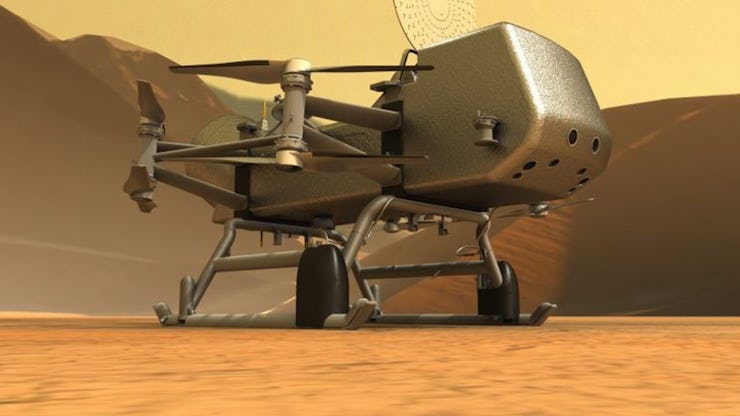How a NASA Drone Could Find Traces of Life on Saturn’s Weirdest Moon
Titan, the second largest moon in our Solar System, is the only known moon with an atmosphere.

The highly-anticipated Dragonfly robotic rotorcraft mission to Saturn’s moon Titan is scheduled to launch in 2027. When it arrives in the mid-2030s, it will hover and zoom around in the thick atmosphere of Titan, sampling the air and imaging the landscape. What could be more exciting than that!?
Well, actually … there’s more: Dragonfly will also be equipped with a mass spectrometer that will help it search for the chemistry of life in this alien world. Astrobiologists want to know if Titan has the same type of chemistry on its surface that Earth did in its early history, which could have helped give rise to life on our planet.
A near-infrared mosaic image of Saturn’s moon Titan shows the sun reflecting and glinting off of Titan’s northern polar seas.
Titan, the second largest moon in our Solar System, is the only known moon with a substantial atmosphere. It is the most Earth-like place we know of, as it has rain, lakes, and oceans. But at Titan’s frigid surface temperatures — roughly -180 degrees Celsius (-292 degrees Fahrenheit) — liquid methane and ethane dominate Titan’s hydrocarbon equivalent of Earth’s water. But this complex carbon-rich chemistry, as well as Titan’s interior the ocean makes it an ideal destination to study the prebiotic chemical processes that could lead to the formation of life.
Dragonfly’s Mass Spectrometer (DraMS) is designed to help scientists remotely study chemistry at work on Titan, measuring samples of Titan’s surface materials to look for evidence of what is called prebiotic chemistry, the chemical steps that lead to the formation of life.
“We want to know if the type of chemistry that could be important for early pre-biochemical systems on Earth is taking place on Titan,” said Dr. Melissa Trainer of NASA’s Goddard Space Flight Center, Greenbelt, Maryland, in a NASA press release.
Trainer, a planetary scientist, and astrobiologist who specializes in Titan, is one of the Dragonfly mission’s deputy principal investigators. She is also the lead on the DraMS instrument.
A mass spectrometer can analyze the various chemical components of a sample by separating these components into their base molecules and passing them through sensors for identification.
Artist’s impression of Dragonfly on Titan’s surface.
Dragonfly will capitalize on Titan’s low gravity (13.8 percent that of Earth), enabling the rotorcraft to remain airborne and perform like a drone, researching a variety of things on Titan, including the atmosphere, the surface, and the methane lakes and rivers.
NASA says that Dragonfly has the ability to fly between different points of interest on Titan’s surface, spread as far as several kilometers/miles apart. This will allow Dragonfly to relocate its entire suite of instruments to a new site when the previous one has been fully explored and provides access to samples in environments with a variety of geologic histories to learn more about the moon’s composition and its potential to support life.
“DraMS is designed to look at the organic molecules that may be present on Titan, at their composition and distribution in different surface environments,” said Trainer. Organic molecules contain carbon and are used by all known forms of life. They are of interest in understanding the formation of life because they can be created by living and non-living processes.
At each site, samples less than a gram in size will be drilled out of the surface by the Drill for Acquisition of Complex Organics (DrACO) and brought inside the lander’s main body to a place called the “attic” that houses the DraMS instrument. There, the samples will be irradiated by an onboard laser or vaporized in an oven to be measured by DraMS.
DraMS utilizes proven mass spectrometer technologies that have been used on the Mars rovers.
“This design has given us an instrument that’s very flexible, that can adapt to the different types of surface samples,” said Trainer.
Dragonfly will land in an equatorial, dry region of Titan called the Shangri-La dune field, close to an 80 km wide (50-mile-wide) crater called Selk. This region was imaged by NASA’s Cassini spacecraft during its mission to Saturn between 2004 and 2017 has a terrain of dunes and shattered, icy bedrock, according to radar imagery from Cassini.
Cassini’s radar image of the Selk Crater, the landing site for the upcoming Dragonfly mission.
This article was originally published on Universe Today by Nancy Atkinson. Read the original article here.